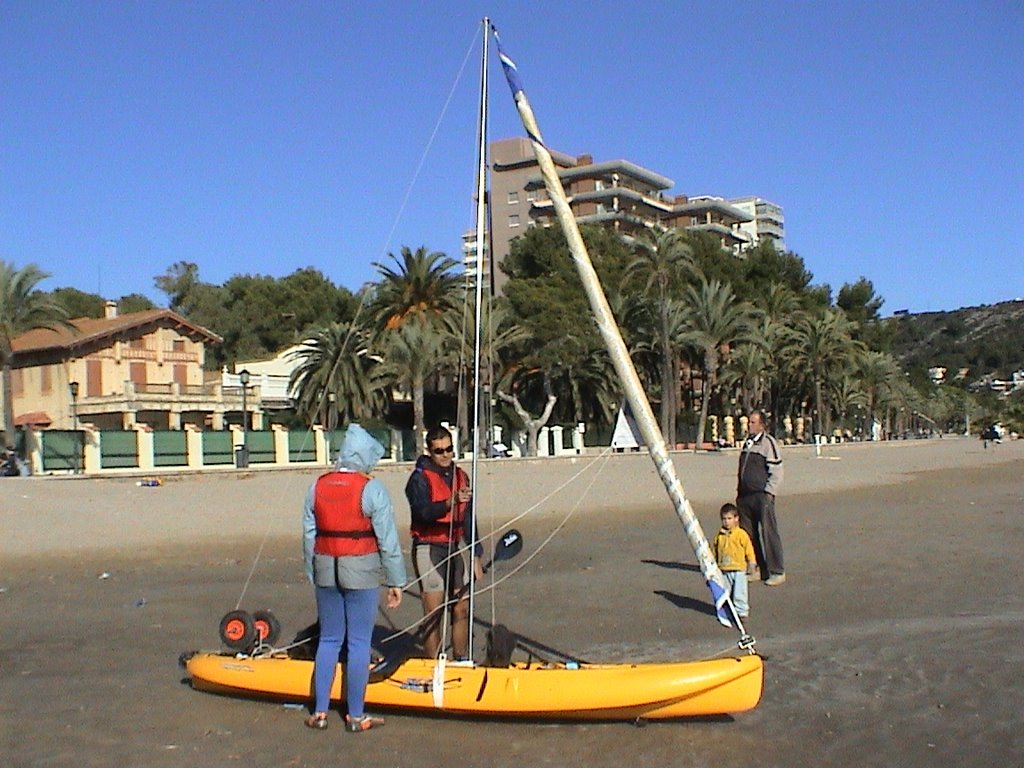STORY OF A SAILING KAYAK
Saturday, August 25, 2007
The New Main

After some months, finally decided to increase de main. For doing this, a stronger and longer mast was adjusted to the kayak. The great thing is that the position of the mast is now much closer to the bow, allowing increase the size of the main up to 6,5 sq. meters.
In order to give some more stability to compensate the larger sail, I made two fiberglass stabilisers connecting them with two aluminium tubes.

Also a roller-furling device has been added to the mast using a piece of wood as roller attached to the lower mast.
After testing it, is the configuration with best performance of all tested untill now. Would be nice to add a jib and see how it works, but may be´d be too much sail.
The question now is how to install a daggerboard , its size and location (midle, closer to bow or to stern) to increase sailing performance and wind reaching.

After some months, finally decided to increase de main. For doing this, a stronger and longer mast was adjusted to the kayak. The great thing is that the position of the mast is now much closer to the bow, allowing increase the size of the main up to 6,5 sq. meters.
In order to give some more stability to compensate the larger sail, I made two fiberglass stabilisers connecting them with two aluminium tubes.

Also a roller-furling device has been added to the mast using a piece of wood as roller attached to the lower mast.
After testing it, is the configuration with best performance of all tested untill now. Would be nice to add a jib and see how it works, but may be´d be too much sail.
The question now is how to install a daggerboard , its size and location (midle, closer to bow or to stern) to increase sailing performance and wind reaching.
Tuesday, December 12, 2006
New Sail

After our experience using a kite, decided to upgrade to a bigger sail. These are some pix from the 1st day tests... Here view of the kayak, with new mast and rigs.

Rig at the top of the mast allows both, rolling the main (if installed) and jib.
Watch the video at:
http://www.youtube.com/watch?v=hE5adcRuC1g

After breaking the original mast insert, it was changed and reinforced and tested with 100% satisfaction.
Special thanks to Benito Cervera, who participated again on the design and construction of the different upgrades made. Also thanks to Pedro Museros, who helped sailing tha kayak during the test. ( Ereh un crack, maestro !!)

After our experience using a kite, decided to upgrade to a bigger sail. These are some pix from the 1st day tests... Here view of the kayak, with new mast and rigs.

Rig at the top of the mast allows both, rolling the main (if installed) and jib.
Watch the video at:
http://www.youtube.com/watch?v=hE5adcRuC1g

After breaking the original mast insert, it was changed and reinforced and tested with 100% satisfaction.
Special thanks to Benito Cervera, who participated again on the design and construction of the different upgrades made. Also thanks to Pedro Museros, who helped sailing tha kayak during the test. ( Ereh un crack, maestro !!)
Saturday, September 23, 2006

After several times, decided to install a jib, easier to handle with, specially when sailing alone. The new rig offered better performance upwind and also increased speed about, 20-25% in light winds.
These are a couple of pix from our 1st testing day. The job was done with the help of Benito Cervera, a well known SAIL MASTER from Castellón, who added materials, knowledge and a very valuable and altruistic effort to get the new rig working in a record time of 48 hours.

When sailing alone, the bow tends to stay out of the water, loosing lateral resistence. This can be solved putting some weight at the front seat.
Also, in a windy day, lateral stabilisers might be requiered to avoid capsizing.
Other solution to both problems would be sitting in the middle of the kayak at the same side from where the wind is blowing.
Monday, August 21, 2006
Some upgrades to ensure funny ride

And here it is my "sock model" daggerboard prototipe, version 1.0. Easy home-made aluminuim 1 mm.

Finally riding the horse again, now less crazy than before installing the daggerboard. It has been really helpful to start real sailing, as without it we´ve not enought lateral resistence.

Another pic, saling Alejandro´s 14 m2 kite.

A funny ride using the 14 sq meter kite

The rudder extension, which allows controling the kayak while using the kite is also aluminium 1mm width. Easier to make than the daggerboard.

And here it is my "sock model" daggerboard prototipe, version 1.0. Easy home-made aluminuim 1 mm.

Finally riding the horse again, now less crazy than before installing the daggerboard. It has been really helpful to start real sailing, as without it we´ve not enought lateral resistence.

Another pic, saling Alejandro´s 14 m2 kite.

A funny ride using the 14 sq meter kite

The rudder extension, which allows controling the kayak while using the kite is also aluminium 1mm width. Easier to make than the daggerboard.
Monday, August 14, 2006

